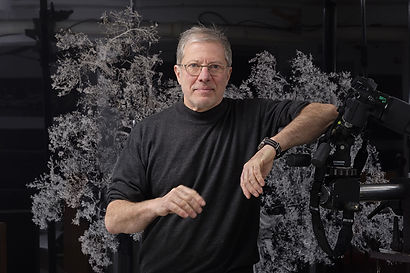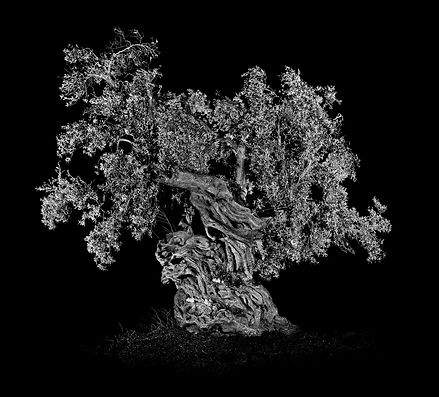
By Baudouin Eschapasse
Published on March 10th, 2025
Antoine Schneck's millenial olive trees
The photographer exhibits hypnotic portraits of immemorial trees in Paris. A series he has been shooting in Puglia for the past fifteen years.

We're all familiar with Antoine Schneck's disturbing portraits of men and women from all walks of life, taken on five continents (from Papua New Guinea to China, via Ghana, Mali and Ethiopia): large-format, camera-ready images from the earliest days of photography. These faces, isolated against a black background, offer a powerful face-to-face encounter with individuals from cultures sometimes far removed from our own. After a series on flowers, made on glass plates using the wet collodion technique, which uses silver salts to fix the imprints left by light..., the artist now invites us to take a look at a new subject: the venerable olive trees of Puglia (Italy).
Each has a name: Ottavio, Gino, Cosimo, Tommaso and Giuseppe. Antoine Schneck met them on a trip to the south of the peninsula some fifteen years ago. These trees, millennia-old inhabitants of the arid Italian countryside, inspired the photographer to take their portraits.
As with his previous series, the artist chose to set them against a black background, as if in a studio (he waited until nightfall to immortalize them, in black and white), so that the light doesn't seem to be projected onto the models, but, on the contrary, radiates from them. The result is a profound change in the way we look at these subjects!

Giuseppe, pigment print, 100 x 120 cm
© Antoine Schneck, Courtesy Galerie Berthet-Aittouarès
A world without traditional artifice
“For a long time, my concern has been to make photographs in which the question of framing, depth of field and lighting do not pollute the way the viewer perceives my images,” explains Antoine Schneck. This approach, which aims to represent the world without resorting to the traditional artifices of his art, contributes greatly to the charm of his work.
Unadorned and devoid of color, trunks and foliage take on a new dimension. “You're not sure whether it's a cliché or an engraving,” smiles the photographer. The sense of proportion is also blurred. Are these tiny bonsai or majestic trees? Reliefs also become blurred: especially on the trunks, where it becomes impossible to discern concave and convex shapes. Adorned in silvery hues, the plants even lose their own identity. “Take these three trunks, which give the impression of dancing. I've renamed them the Three Graces, so elegant is the movement of their branches,” explains Antoine Schneck. This metamorphosis is due to a manufacturing secret. Each image is an assemblage of some twenty different photographs, each uniquely lit.
“On one, I placed low-angled spotlights highlighting the bark's veins, while on the other, a flash in the canopy illuminated the most hidden leaves, as if the tree itself were sparkling,” explains the artist. These manipulations help to bring the silhouette of the branches out of nothingness, and to make these trees phosphorescent, reverberating light like diamonds.
This lengthy post-production work enabled Antoine Schneck to recompose a singular image for each olive tree, and to verify the accuracy of the words of painter John Constable (1776-1837): “no two leaves of a tree have ever been alike since the creation of the world; and the pure and authentic productions of art, like those of nature, are all distinct from each other”.

Ottavio, pigment print, 100 x 100 cm
© Antoine Schneck, Courtesy Galerie Berthet-Aittouarès
Exhibition "Oliviers" by Antoine Schneck
Galerie Berthet-Aittouarès, 14 et 29, rue de Seine, Paris 6e. Until March 29th, 2025
Tél. : +33 (0)1 43 26 53 09. Site Internet : galerie-ba.com.




